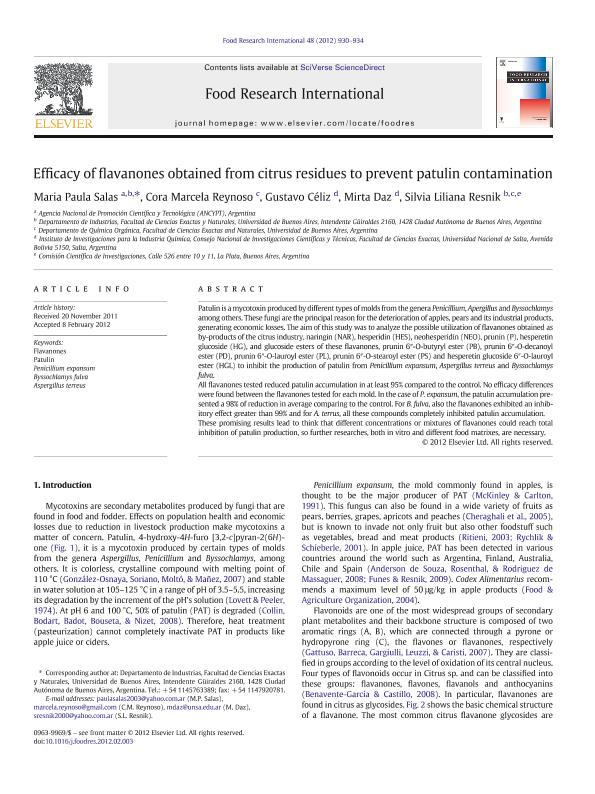Artículo
Efficacy of flavanones obtained from citrus residues to prevent patulin contamination
Salas, Maria Paula; Reynoso, Cora Marcela; Celiz, Gustavo ; Daz, Mirta Elizabeth; Resnik, Silvia Liliana
; Daz, Mirta Elizabeth; Resnik, Silvia Liliana
 ; Daz, Mirta Elizabeth; Resnik, Silvia Liliana
; Daz, Mirta Elizabeth; Resnik, Silvia Liliana
Fecha de publicación:
10/2012
Editorial:
Elsevier Science
Revista:
Food Research International
ISSN:
0963-9969
Idioma:
Inglés
Tipo de recurso:
Artículo publicado
Clasificación temática:
Resumen
Patulin is a mycotoxin produced by different types of molds from the genera Penicillium, Apergillus and Byssochlamys among others. These fungi are the principal reason for the deterioration of apples, pears and its industrial products, generating economic losses. The aim of this study was to analyze the possible utilization of flavanones obtained as by-products of the citrus industry, naringin (NAR), hesperidin (HES), neohesperidin (NEO), prunin (P), hesperetin glucoside (HG), and glucoside esters of these flavanones, prunin 6"-O-butyryl ester (PB), prunin 6"-O-decanoyl ester (PD), prunin 6"-O-lauroyl ester (PL), prunin 6"-O-stearoyl ester (PS) and hesperetin glucoside 6"-O-lauroyl ester (HGL) to inhibit the production of patulin from Penicillium expansum, Aspergillus terreus and Byssochlamys fulva. All flavanones tested reduced patulin accumulation in at least 95% compared to the control. No efficacy differences were found between the flavanones tested for each mold. In the case of P. expansum, the patulin accumulation presented a 98% of reduction in average comparing to the control. For B. fulva, also the flavanones exhibited an inhibitory effect greater than 99% and for A. terrus, all these compounds completely inhibited patulin accumulation. These promising results lead to think that different concentrations or mixtures of flavanones could reach total inhibition of patulin production, so further researches, both in vitro and different food matrixes, are necessary. © 2012 Elsevier Ltd.
Archivos asociados
Licencia
Identificadores
Colecciones
Articulos(INIQUI)
Articulos de INST.DE INVEST.PARA LA INDUSTRIA QUIMICA (I)
Articulos de INST.DE INVEST.PARA LA INDUSTRIA QUIMICA (I)
Citación
Salas, Maria Paula; Reynoso, Cora Marcela; Celiz, Gustavo; Daz, Mirta Elizabeth; Resnik, Silvia Liliana; Efficacy of flavanones obtained from citrus residues to prevent patulin contamination; Elsevier Science; Food Research International; 48; 2; 10-2012; 930-934
Compartir
Altmétricas



